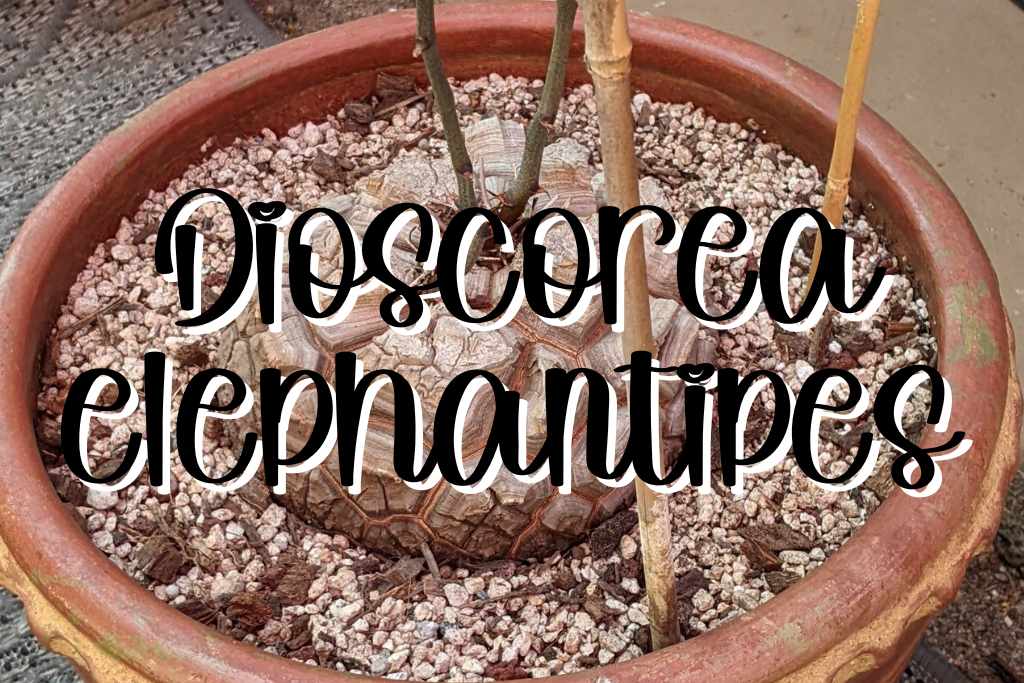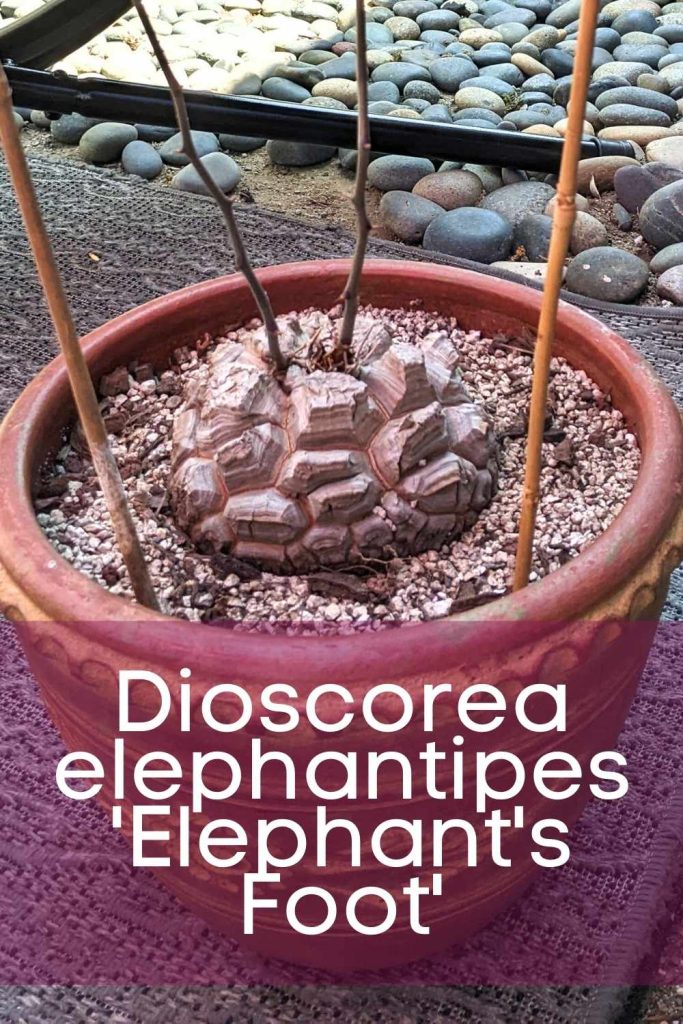Hey there, fellow plant enthusiasts! Today, we’re diving into the world of ‘Elephant Foot Plant’, or Dioscorea elephantipes. This unique and fascinating succulent has captured the hearts of many, and we’re about to uncover all there is to know about taking care of this special plant. So, let’s get started!
Dig in!

Introduction to Dioscorea elephantipes ‘Elephant Foot Plant’
The ‘Elephant Foot Plant’, scientifically known as Dioscorea elephantipes, is a slow-growing, drought-tolerant succulent native to South Africa. This peculiar plant is known for its distinctive, thick caudex that resembles an elephant’s foot, hence the name.

Source: Etsy
Natural Habitat and Other Common Names
‘Elephant Foot Plant’ Dioscorea elephantipes can be found in the arid regions of South Africa, particularly in the Eastern Cape and Northern Cape provinces. It’s also commonly known as the ‘Hottentot Bread,’ ‘Turtle Shell Plant,’ and ‘Elephant’s Foot Yam.’

Source: Etsy
Unique Adaptations and Appearance
‘Elephant Foot Plant’ Dioscorea elephantipes has a few adaptations that help it survive in its natural environment. Its thick, woody caudex stores water, allowing the plant to withstand long periods of drought. The caudex of ‘Elephant Foot Plant’ Dioscorea elephantipes also has a cork-like texture, which helps protect it from herbivores.

The plant’s leaves grow on long, vine-like stems, which can reach up to 10 feet in length. This growth pattern allows the leaves to capture sunlight efficiently while keeping the caudex shaded and cool.

Source: Etsy
Differentiating Dioscorea Elephantipes
‘Elephant Foot Plant’ Dioscorea elephantipes can be easily distinguished from other succulents by its unique caudex and vine-like stems. No other succulent boasts the same elephant foot-like appearance, making this plant a true stand-out in any collection.

Source: Etsy
What is a caudex?
In the plant world, a caudex is a thickened stem or trunk. You often find it in plants that have adapted to dry, desert-like areas with little water. The caudex acts as a storage unit, allowing the plant to stockpile water and nutrients during periods of drought.
Caudices come in different shapes and sizes, from small and rounded to large and columnar. They tend to grow slowly over very long periods. The outer layer of the caudex is often rough like bark, while the inner tissue can be soft and spongy or fibrous.
Many plants with caudices belong to the families of succulents and desert plants. Examples include species of Adenium, Pachypodium, and Dioscorea. These plants have evolved the ability to store water in their caudices, helping them endure harsh desert conditions with little rainfall. Without their caudices, they would likely struggle to survive extended dry spells.

Source: Etsy
Flowers and Blooming
The flowers of ‘Elephant Foot Plant’ Dioscorea elephantipes are small, greenish-yellow, and bell-shaped. Blooming typically occurs from late autumn to early winter and is triggered by a combination of shortening day length and cooler temperatures.

Source: Etsy
Growth Rate and Season
Elephant Foot Plants are known for their slow growth rate, often growing less than an inch per year. They typically experience active growth during the cooler months of the year, from late autumn to early spring.

Source: Etsy
Light and Cold Hardiness
‘Elephant Foot Plant’ Dioscorea elephantipes prefers bright, indirect light and can tolerate some direct sunlight. However, too much direct sun can scorch the leaves. As for cold hardiness, it can withstand temperatures as low as 28°F (-2°C), but it’s best to protect the plant from freezing conditions.

Source: Etsy
Watering and Care of your Dioscorea elephantipes
When it comes to watering, ‘Elephant Foot Plant’ Dioscorea elephantipes prefers a “drench and dry” method. Water the plant thoroughly, allowing the excess to drain away, and then let the soil dry out completely before watering again. During the active growing season, water once every two weeks, and reduce the frequency to once a month during dormancy.

Source: Etsy
Temperature Tolerance and Rain
As mentioned earlier, Dioscorea elephantipes can tolerate temperatures down to 28°F (-2°C). However, it’s not a fan of wet conditions, so it’s best to bring it indoors or provide shelter during heavy rain to prevent the caudex from rotting.
When you’re rooting or transplanting your succulents and cacti, use SUPERthrive to help reduce the chance of transplant shock and grow a strong root system.
Fertilizing Your Plant
Fertilize your ‘Elephant Foot Plant’ Dioscorea elephantipes sparingly, using a balanced, water-soluble fertilizer diluted to half strength. Apply the fertilizer every two to three months during the active growing season.

Succulent fertilizer available to purchase on Etsy.
Propagation and Pruning
Propagation of ‘Elephant Foot Plant’ Dioscorea elephantipes is typically done through seed germination. However, it can also be propagated using cuttings from the vine-like stems. To propagate from cuttings, allow the cut end to callus over for a few days before placing it in well-draining soil. As for pruning, it’s generally not necessary, but you can trim the vines to maintain a desired length.

Consider amending your soil with Bonsai Jack’s gritty mix to ensure your succulent soil drains quickly to prevent it from staying moist for too long. Source: Etsy
Common Problems and Pests
Common problems encountered when growing an ‘Elephant Foot Plant’ Dioscorea elephantipes include overwatering, which can lead to rot, and sunburn from excessive direct sunlight. Pests are not a significant issue, but keep an eye out for mealybugs and scale insects, which can be managed with insecticidal soap or neem oil.

Source: Etsy
Growing Indoors and Pet Safety
Yes, you can grow ‘Elephant Foot Plant’ Dioscorea elephantipes indoors! Just make sure it receives plenty of bright, indirect light. As for pet safety, there’s no evidence to suggest that the plant is toxic to cats, dogs, or people. However, it’s always a good idea to keep plants out of reach of curious pets and children.

Source: Etsy
Dormancy in Elephant Foot Plants
Dioscorea elephantipes enters a state of dormancy during warmer seasons to conserve energy and cope with dry or unfavorable conditions. This adaptive trait is common among plants native to tropical and subtropical climates that experience distinct seasonal changes.
For Dioscorea elephantipes, dormancy typically occurs from late spring through early autumn. During this period, the plant shuts down most active growth processes in response to higher temperatures and less available moisture. New leaf production slows or stops, stems become less supple, and internodes (spaces between leaves) shorten.

Source: Etsy
The caudex (thickened stem) of Dioscorea elephantipes allows it to survive the dormant season by storing water and nutrients. Over time, as the caudex enlarges, the plant’s ability to endure dormancy improves. Well-established specimens that have developed extensive caudices can often go months with minimal care during their dormant phase.
To determine if your Elephant Foot Plant is dormant, examine the growth rate and flexibility of new stems. Actively growing Dioscorea elephantipes produces supple stems with longer internodes as it puts out new leaves at a steady pace. In dormancy, stems tend to harden and thicken while internode length shortens, reflecting slower growth.

Source: Etsy
During dormancy, water Dioscorea elephantipes only when the top few inches of soil are dry. Severely withholding water is not recommended, as the plant’s caudex still requires moisture to retain its stored reserves. However, reduced watering mimics the plant’s natural seasonal conditions and helps it effectively navigate dormancy.
With careful monitoring and minimal care, Dioscorea elephantipes can reliably emerge from its dormancy once conditions become favorable again, usually in late autumn as temperatures cool. Its adaptive dormancy strategies enable this remarkable plant to thrive in environments with variable seasons.

Source: Etsy
Etymology and Medicinal Uses
The name “Dioscorea” comes from the Greek physician and botanist Dioscorides, while “elephantipes” refers to the plant’s distinctive, elephant foot-like caudex. As for medicinal uses, ‘Elephant Foot Plant’ has not been widely studied, but some traditional uses include treating inflammation and pain.

Source: Etsy
And there you have it! A comprehensive care guide for the unique and captivating Elephant Foot Plant. By following these tips, you’ll be well on your way to growing a healthy and happy Dioscorea elephantipes.


